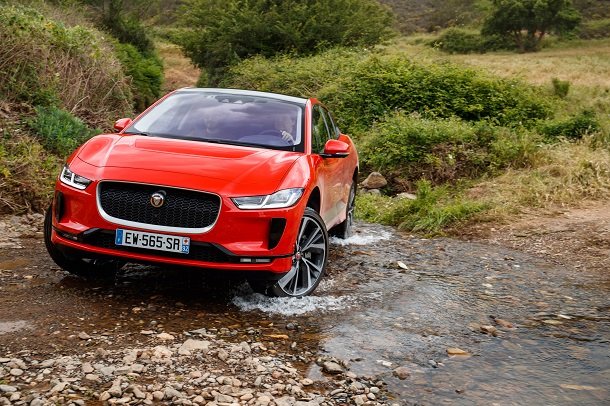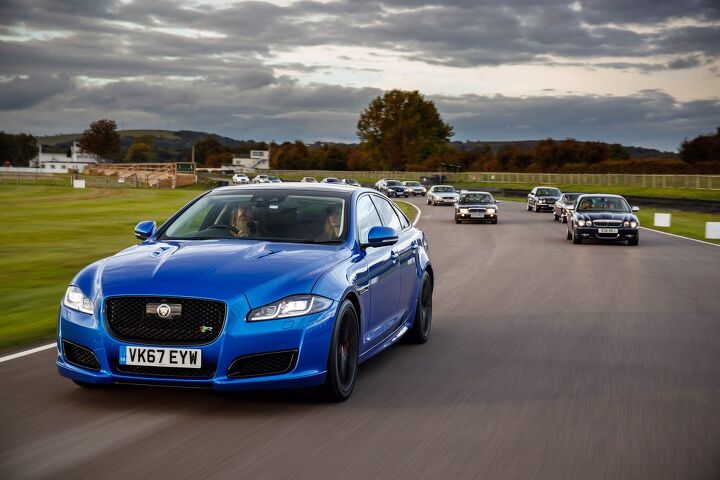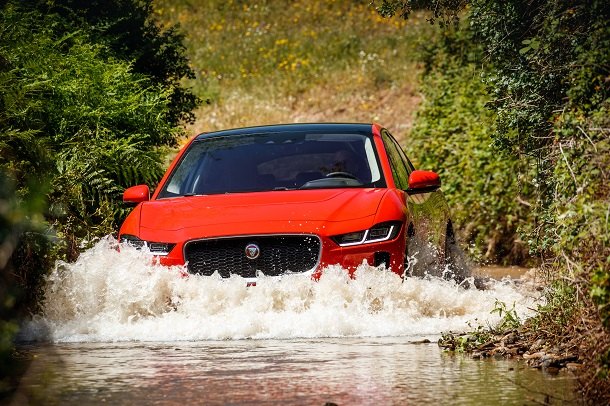#i-pace
Jaguar Is Going to Try and Sell the I-Pace in India
Jaguar Land Rover unveiled its all-electric SUV to the Indian market this week, proving that it’s dead serious about expanding the I-Pace’s customer base. While parent company Tata Motors undoubtedly has a fondness for its home region, we cannot help but wonder if its a market worthy of pursuit considering the model’s starting price.
The manufacturer has the (90-kWh) I-Pace stickered at 105.91 lakh rupees, which translates to about $147,000 USD. Considering the unique way India writes out denominations and often transitions between crore and lakh as a way to avoid listing high-value items in the millions of rupees, we were initially convinced we’d messed up the conversion. The sum would not only eclipse the $70,000 MSRP Jaguar has affixed to the I-Pace in the United States, it makes it highly uncompetitive against the luxury EVs already on a market that’s not known for its wealthy consumer base. How could this be JLR and Tata’s preferred strategy?
Jaguar Going All Electric By 2025, Cancels Electric XJ Sedan
Jaguar Land Rover (JLR) has announced that it plans to have transitioned the Jaguar side of the business entirely to electric vehicles by 2025. Meanwhile, the more profitable Land Rover brand will be receiving its very first EV sometime in 2024. The plan is backed by a £2.5 billion (roughly $3.5 billion USD) investment.
As usual, take these promises with a grain of salt. Practically every manufacturer has underdelivered when it comes to electrification and features existing under the catch-all mobility tag. Jaguar’s current battery-electric vehicle, the I-Pace, hasn’t exactly been a smash hit and its construction is actually contracted out to Magna Steyr in Graz, Austria. Jag also recently abandoned the new XJ model, which has been in development for years. Ironically, the car was supposed to become the brand’s first all-electric sedan.
2019 Jaguar I-Pace EV400 HSE Review - EV Growing Pains Persist
Jaguar’s I-Pace electric hatchback provides an interesting driving experience. When it has enough charge to be driven, that is.
The I-Pace I drove for a weekend last summer spent much of that time at the dealership, charging, because it failed to charge anywhere else near my home.
More on that in a minute.
Battery Shortage Dims the Lights on Jaguar I-Pace Production
Jaguar Land Rover is reportedly putting I-Pace production on hold for a week thanks to a battery shortage at supplier LG Chem.
While sales of the model are ridiculously low in North America, European deliveries average about 1,000 units per month. That’s comparable to the Audi e-Tron, which also suffered production delays due in part to its relationship with the supplier. Before that, Hyundai was the one pointing the finger at LG Chem after running out of batteries for the Ioniq EV.
The 8-percent Solution: Range Boost Incoming to Jaguar I-Pace Owners
Maybe electric racing does have something to offer the common man. Jaguar credits its Jaguar I-Pace eTrophy race series (outside makes need not apply) for returning data that proved useful in eking out additional range from the electric crossover’s 90 kWh battery pack.
As things are all very modern in 2019, all Jag needs to do to pass the fruits of that knowledge on to consumers is fix them up with a software update.
Plow King: Electronic Nannies Give Jaguar I-Pace a Black Eye in Moose Test
Jaguar’s electric I-Pace (not to be confused with the gas powered E-Pace) earned unflattering press this past summer after slow sales led to ballooning inventories of the brand’s first EV. Now, there’s another PR stroke against the model, and electricity once again lies at the core of the issue.
As new safety features proliferate across the industry, electronic stability control stands out as one of the veteran lifesaving nannies, joining the fray after anti-lock brakes, airbags, and crumple zones became the norm. In the I-Pace’s case, ESC conspired to turn the model’s “moose test” into a viral sensation.
Jaguar Land Rover Less Certain About Battery Powered SUVs in 2019
Despite delivering what could be considered a desirable premium EV with the I-Pace, Jaguar Land Rover admits it’s not entirely sold on the idea of electric sport utility vehicles. Due to their size, SUVs and crossovers are inherently heavier than traditional sedans — placing them at odds with the goal of maximizing efficiency.
More mass means diminished range. While this can be offset by a manufacturer installing larger battery packs, that increases costs and ultimately adds more heft to the single heaviest component in an EV. Large electrics bring other issues to the engineering table, too.
“The larger the vehicle the larger the aero challenge. If you’re not careful you end up with such big batteries and you make the vehicles so heavy that as you race down the autobahn the range disappears,” Nick Rogers, JLR’s head of engineering, told media at the company’s revamped engineering and design center in Gaydon, England.
Jaguar Land Rover Readies XJ Successor, New SUV
With Jaguar’s XJ sedan on its way out, the company is actively working on a replacement using its new Modular Longitudinal Architecture (MLA). Like many modern platforms, MLA can be be adapted for use in electric, plug-in hybrid, and mild-hybrid applications… and the automotive firm no doubt plans to squeeze every dime it can out of that built-in versatility.
Following the debut of a large premium sedan that’s supposed to replace the XJ sometime next year, MLA will see action at Land Rover — underpinning the new Ranger Rover in 2021. Eventually the automaker intends to use MLA as the basis for most future models, hopefully reducing development and manufacturing costs after posting a $4.6 billion loss earlier this year.
Jaguar's J-Pace Gradually Takes Shape
While Jaguar is working towards padding out its utility lineup, the company has yet to deliver anything exceptionally large. Though not minuscule, neither the midsize F-Pace or smaller E-Pace are capable of swaying someone in the market for an Escalade — and don’t get us started on the slow-selling I-Pace (above).
The company needs a hit, especially now that Chinese sales have fallen off a cliff and the rest of the world cannot make up the difference. Sedans sales are floundering. As Jaguar Land Rover explores cost-cutting measures (mainly staff reductions and a scaling back of R&D), it’s also attempting to simultaneously improve its corporate fuel economy average while anticipating Britain and the EU’s next move re: Brexit. It’s a bad situation and the only saving grace is the company’s SUVs.
Fortunately, JLR has a bundle of new vehicles on the way, all borrowing the new MLA platform. Still a couple of years away, introductory models are said to include the fifth-generation Range Rover and Jaguar’s J-Pace. Jag’s new, larger SUV offering is shaping up a little different than expected, as reports claim Jag has abandoned mechanical all-wheel drive.
2019 Jaguar I-Pace First Drive - Electric Avenue Now Has More Traffic
Editor’s Note: This article is written by contributor Jeff Taylor. Due to technical difficulties, it is under the TTAC Staff byline. Once those difficulties are fixed, Jeff’s name will be properly attached.
Jaguar’s new I-Pace EV is the first vehicle in the automaker’s plan to fully electrify — or electrically assist — all of its vehicles beginning in 2020.
The I-Pace raises the question: can Jaguar’s EV powertrain live up to everyday driving demands and deliver the premium experience luxury buyers demand without a huge power-suck mileage penalty?
Additionally, mainstream and luxury manufacturers have announced aggressive electrification plans of their own, which puts more heat on Jaguar to get it right or risk its plug being pulled.
To gauge Jaguar’s level of success, I spent some time in Lisbon, Portugal for the I-Pace Media Drive. During the launch program, I put the I-Pace through some tough driving situations and made some surprising discoveries about both the vehicle and what it means for the industry moving forward.
Jaguar Land Rover Wants to Build Cars in the U.S., but Only If Americans Buy More
Jaguar Land Rover says it’s totally stoked at the idea of establishing a production facility in the United States, but claims Americans will probably need to buy a few more cars before that vision can become a reality. This might not be a problem, as U.S. buyers have been all about JLR lately. Group sales were the best in over fifteen years in 2016 and last year saw the company achieve a record high of 114,333 deliveries.
While the majority of those sales come from Land Rover, Jaguar has also seen impressive growth over the last three years. More North American sales are definitely coming, especially with Rover already looking to have one of its best years on record in just the first three months of 2018. So why won’t the manufacture pull the trigger and start laying the groundwork on a new factory?
Jaguar Land Rover Promises Electrified Lineup From 2020 Onward, Includes Vintage E-Type
Jaguar Land Rover is buzzing this week with news that every single model introduced after 2020 will be electrified.
Excited to showcase its “commitment to the future,” JLR even provided a converted E-Type for its mobility-themed Tech Fest. Dubbed the E-Type Zero, the car is a 1968 Series 1.5 Roadster with its traditional powertrain swapped in favor of a 220 kW electric motor. While the old EV switcharoo provides instantaneous torque, an increase in horsepower, and ought to make fans of the cars in Gattaca very happy, Jag purists will probably hate it.
However, the company’s decision isn’t about a high-profile one-off. This is a sea change for JLR, echoing Volvo’s recent decision to march headlong into electrification.


























Recent Comments